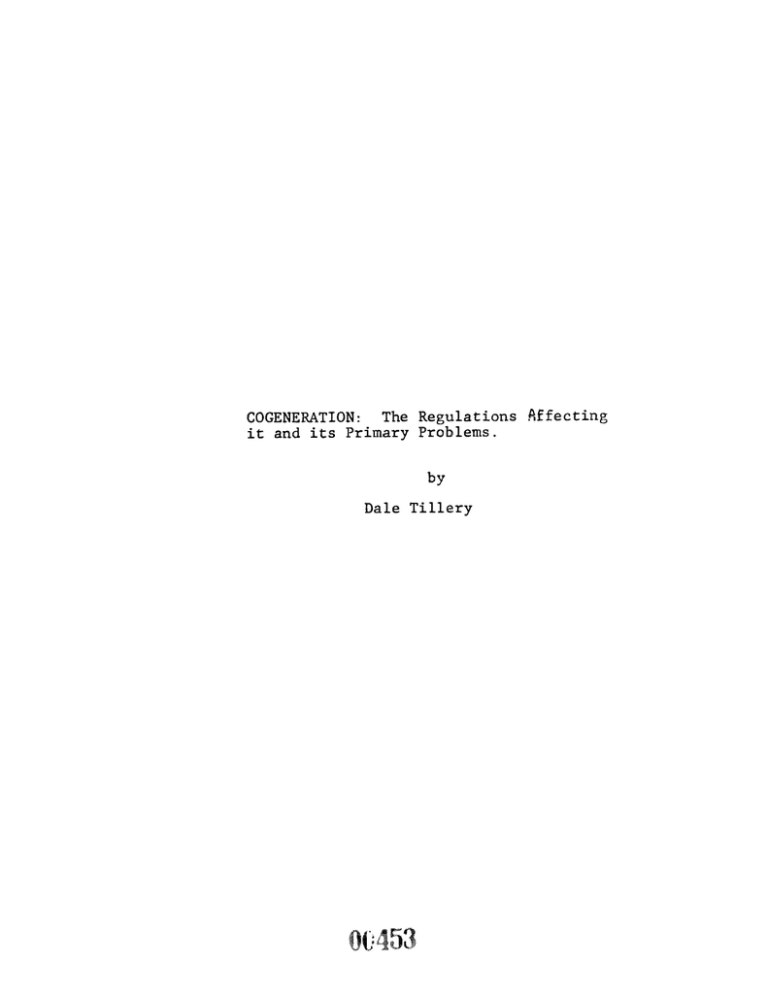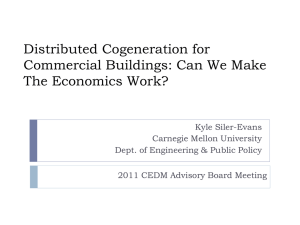00453 COGENERATION: The Regulations Affecting it and its Primary Problems. by
advertisement

COGENERATION: The Regulations Affecting it and its Primary Problems. by Dale Tillery 00453 The recent sharp increase in the price of fossil fuels has forced industry to search for methods which will reduce their generation expense. The search has lead to a reju- vented interest in cogeneration; however, the pursuit of cogeneration has created unique problems. The United States government views the dependence on fossil fuels as a threat to our national interest. To re- duce our dependence on fossil fuels, the government has tried to structure a regulatory system which aims to encourage the use of cogeneration while avoiding damage to public utilities. The growth of cogeneration has stimulated debate in several areas. One area of debate involves the financial incentives and disincentives for industries interested in utilizing cogeneration. Utilities have voiced opposition to cogeneration and have erected barriers to its implementation, thus drawing strong criticism from cogeneration supporters. A dispute exists concerning whether cogenera- tion facilities should be large and centralized or small and decentralized. States will play an important role in cogeneration and are just beginning to grappel with the problems presented, and to discover the benefits available. Finally, with the change in administration, a glimpse of cogeneration1s future may be obtained by examining the present administrations policy concerning cogeneration. 00454 -1- On April 20, 1977, President Jimmy Carter made a speech 1 in which he coined the term cogeneration. President Carter defined cogeneration as "the production of electric power and other forms of useful energy - such as heat or process steam 2 from the same facility.'8 For legislative purposes, coge- neration is defined as "(i) electric energy, and (ii) steam or forms of useful energy (such as heat) which are used 3 for industrial, commercial, heating, or cooling purposes." The process President Carter referred to as cogeneration is not a new concept. Before being termed cogenera- tion, the process was known as "in-plant generation," "by 4 product power," or "total energy system." Fifty years ago, the United States produced close to twenty five percent of 5 of its own energy through cogeneration; however, the large drop in the cost of electric energy and the improvement in the availability of reliable electric energy has caused a decline in energy produced 6by cogeneration to about four percent of its energy output. Cogenerated energy is generally produced by one of two commonly used methods. One cogeneration process is referred to as a topping cycle. In a topping cycle, fuel is burned to produce electricity and the heat from the generation 7 system is used to meet thermal heating requirements. other commonly used method is a bottoming cycle. The In a bot- toming cycle, fuel is burned to produce heat for the industrial 00455 -2process or thermal needs (ex. smelting or kiln baking). 8 The exhaust heat from, the industrial process is then used to generate electricity. These systems are most beneficial when an industry has a high heat requirement and high utilization 9 of the industrial process. The use of cogeneration is viewed as one way to reduce our dependence on fossil fuels by being more efficient in our fuel use. The overall United States utility fuel efficiency rating is twenty nine percent and with improvements in tech10 nology it may be improved by one or two percentage points. Cogeneration offers vast improvements in fuel efficiency without any new technology." By moving the locus of gene- rating plants close to thermal energy users and interconnecting them with the electric.grid, efficiency ratings of eighty percent are attainable which is two and one half to 12 three times greater than the present efficiency ratings. The potential benefit from the use of cogeneration could be quite significant. Aside from the afore mentioned efficiency improvement, it is estimatedvthe use of cogeneration could eventually save as much as two million barrels of 13 oil a day. One estimation claims wide use of cogeneration could reduce fuel use in 1995 by seventy thousand barrels of oil a day, fifty nine billion cubic feet of gas a 14 year, and two hundred and three billion cubic feet of coal. Another report asserts, a coal burning generator's efficiency can -14be increased from thirty three percent to eighty five 15 percent. Sweden has reduced its fuel loss through heat 16 waste, to forty seven percent, by cogeneration. Cogene- ration could make a similar reduction in the United States' 17 present sixty eight percent fuel loss due to heat waste. The basic legislative policy regarding cogeneration is stated in the Public Utility Regulatory Policies Act of 18 1978 (PURPA). PURPA broadly defines a cogenerator as a facility which produces "electrical energy" and "steam or forms of useful energy (such as heat) which are used for IS industrial, commercial, heating, or cooling purposes." Under PURPA congress has granted the Federal Energy Regulatory Commission (FERC) the authority to promulgate regulations which would accomplish PURPA1s broad goals for encouraging the sale and purchase of electricity from 20 cogenerators and small power production facilities. FERC's regulations have established standards which must be met in order for a facility to qualify as a cogenerator or a small power producer. Generally, a facility qualifies as a cogenerator if it meets operating and 21 efficiency standards and ownership criteria. The parti- cular operating and efficiency standards applicable depend upon whether the facility is a topping or bottoming cogene22 rator. The ownership criteria does not allow a facility to be owned by a person primarily engaged in the generation 00457 -1573 or sale of electricity. The ownership requirement is intended to prevent cogenerators from being owned by utilities; therefore, no more than fifty percent of the facilities 24 equity interest can be held by a utility. FERC's regulations, which were promulgated to achieve congressional policies regarding the purchase and sale of electricity between cogenerators and a utility under section 210 of PURPA, requires the utilities to deal fairly with cogenerating facilities. In the area of rate setting for purchase of power, the regulations require utilities to make data available from which the utility's "avoided cost" 25 may be derived. The regulations clearly require electric utilities to 26 purchase energy from cogenerators; however, a utility is not required to purchase a qualifying facility's electric energy if the utility can demonstrate the energy would cost 27 more to purchase than it would to produce. The utility must also notify the state utility commission and the 28 cogenerator of its decision not to purchase energy. Utilities are prohibited from discriminating against cogenerators; however, the utility can not be required 29 to pay more than the "avoided cost" for purchases. The state regulatory authorities may allow rates below "avoided 30 cost" if it is deemed sufficient to encourage cogeneration. The regulations contain a list of factors which should be 31 considered when determining "avoided cost." 00458 -5Utilities must providet upon request by a cogenerator, supplementary power, back-up power, maintenance power, and 32 interruptible power unless the utility can prove it would be unduly burdened or it would be unable to render adequate 33 service to its customer. Utilities are also obligated to sale to a cogenerator any energy and capacity requested by the 34 cogenerator. FERC's regulations expressly state that a utility's rates shall not discriminate between a cogenerator 35 and the utility's other customers. In setting rates for these services, the utility may not assume all interconnected cogenerators will simultaneously transfer produced energy or 36 transfer their energy during the utilities peak hours. The utility must also take into consideration any possible coordination of the cogenerator1s production period with 37 the utility's production schedule. The utility must interconnect with a qualifying cogenerator upon the facility's request; however, the qualifying 38 facility is obligated to pay any interconnection costs. The reasonable cost of interconnection is to be determined 39 jointly by the utility and the state utility commission. In the event of an emergency, a cogenerator may be required to provide energy or capacity to an electric utility; although, the cogenerator and the utility may set the terms of an emergency sale by contract. The regulations also allow the utility to discontinue purchases and sales of energy w4oy -10to cogeneration facilities during emergencies if the sale discontinuation is non-discriminatory or the purchase would 40 contribute to the emergency. FERC's regulations delegate to the state utility commissions the responsiblity of determining standards 41 for the safety and reliability of interconnected facilities. The state commissions are also required to implement rules and regulations governing disputes, between cogeneration facilities and electric utilities, concerning the utilities' rates for purchase or sale of42 energy, interconnection cost or system emergency disputes. The regulations specifically exempt qualifying cogeneration facilities from incremental pricing under the Natural Gas Policy Act of 1978. The qualifications for the ex- emption are basically the same as the qualifications a cogenerator must meet under section 201 through 207, with added efficiency standards tailored for the various types of 43 cogeneration facilities being operated. The qualifications for the exemption generally do not affect new cogeneration facilities because they are employed solely to achieve efficiency; however, older cogeneration plants should take heed of these requirements. FERC's requlations also exempt cogeneration and small power production facilities from certain provisions of the Federal Powerft.ct,the Public Utility Holding Company Act, 00460 -14and state laws or regulations pertaining to the rates of electric utilities, and the financial and organizational 44 regulation of electric utilities. Problems in these areas are generally easily avoided; however, if confronted with such a problem, consult the specific exemption under the particular act or state law in question. The guideline for the creation of incentives for cogeneration was to structure a system which would create a price high enough to encourage the generation and sale of electricity by industries, but low enough to benefit 45 the utility and its other customers. To make cogeneration attractive, regulations were promulgated to insure a reasonable return on a cogenerator1s sale of electricity. created PURPA. In pursuit of this goal, congress Section 210 of PURPA dictates that the purchase rate of electricity, from cogeneration facilities, shall not exceed the incremental cost to 46 the electric utility of alternative electric energy. The policy mandated by Section 210 of PURPA has come to be known as "avoided cost."47 A utility's "avoided cost" is computed by taking capacity and energy cost, which a utility would incur in order to meet a particular demand, and compare that cost with the cost the utility would incur by purchasing the energy to meet the particular demand from a qualifying cogeneration 00461 —s— facility. The amount the utility must pay for the energy is the cost the utility avoids by purchasing and not pro48 ducing the energy. The factors to be considered in arriving at the "avoided cost" has been left to the state 49 power commissions. "Avoided cost" encourages cogeneration because it assures the industrial producer of power a rate of return which is often above the rate charged for the electricity purchased from the utility by the industry. If an industry pays close attention to a utility's rate structure, it may gain an additional benefit under Section 210 of PURPA. sale provision. Section 210 contains a simultaneous purchasePursuant to the purchase-sale provision, the electric utility purchases all of the cogenerator's electrical output and then sales to the cogenerator all the cogenerator's electricity requirements at the regular 50 commercial or industrial rate. The utility must give the cogenerator the option of a simultaneous purchase-sale agreement or an agreement which provides 51 for the purchase of the cogenerator's excess electricity. The effect of the purchase-sale agreement is to encourage the use of cogeneration in a situation where the utility's "avoided cost" of purchasing electricity is lower than its industrial electricity rate in addition to the incentive to cogeneration when the utility's "avoided cost" of acquiring alternative electricity is greater than its 00462 -952 industrial electricity rate. In addition to the legislative incentives for cogeneration, there are tax incentives for cogeneration. The present tax structure allows cogenerators to take advantage of a ten percent investment tax credit plus an eleven percent energy investment tax credit for the full value of the project. The effect of the tax law is to allow the taxpayer to claim a twenty one percent tax credit (twenty one percent of the total cost of the project) against his taxes even if the taxpayer does not finance the total project himself 53 but instead borrows the money. Another potential financial incentive to cogeneration is the use ofvexempt municipal bonds. The scenario calls for waste heat produced by municipal solid waste processing facilities to be converted into electricity. The necessary construction and interconnection of a cogeneration facility, which would be owned by a public power authority, could be financed by tax exempt bonds. This facility would then provide an industrial firm with 54 a portion of the cogeneration facility's production capacity. In order to retain the tax exemption, the industrial firm would have to restrict its purchased capacity to under twenty five percent of the facility's capacity and its annual payments could not equal55 nor exceed three percent of the annual debt service amount. The major disincentive to cogeneration is the large 00463 -10capital expenditure which is required to enable an industry to develope a cogeneration system compatible with the industry's 56 need. Supporters of cogeneration have clammered for invest- ment incentives which allow industries to produce on site electricity cheaper than central station produced electricity cost to purchase. After the year 1990, the use of natural gas or petroleum may be prohibited in any existing major fuel burning installation; furthermore, the use of natural gas or petroleum, as a primary energy source in a new installation, is prohibited according to the Powerplant and Industrial Fuel Use 57 Act (PUA). It is possible for a cogenerator to obtain an exemption, from the PUA regulations, by demonstrating the benefits of cogeneration can not be obtained without using 58 oil or gas in the industrial boiler; however, the exemp- tion does not alleviate the need for a large capital expenditure because cogeneration equipment must be purchased whether the boilers burn oil, gas, or some alternative fuel. Industry has voiced concern because they are now faced with the problem of making a large capital expenditure to convert their present facilities to cogeneration facilities or to make a capital expenditure for changing its present system over from a natural gas or petroleum 59 system to an alternative primary energy source system. In most instances, an industry using natural gas or petroleum fired 00464 -10boilers can be operated on coal; as a result, the industry's 60 equipment must either be converted or replaced. The present cost of implementing a new-coal fired steam plant amounts to about fifty to seventy five percent 61 of the cost of an industrial facility. To make matters worse, the conversion to a coal burning facility does not make the facility a cogenerator. To convert the new coal burning facility to a cogenerator, the industry must incur 62 an additional expense of ten to twenty percent. The additional ten to twenty percent investment may be readily absorbed by an industry if the industry opts for total plant renovation or if the concerned plant is currently in the planning or construction stage; however, if the business capital resources are marginal and the business only wants to convert its existing equipment to coal, or another alternative primary energy source, then the additional ten to twenty percent expenditure for cogeneration equipment may be cost prohibitive without some form of financial assistance. Even industries with the financial ability to make the switch to cogeneration are reluctant to do so because they prefer to invest their capital funds into projects which increase productivity and expand the business Businesses often demand a higher rate of return on a cogeneration investment than they do on a production investment, since cogeneration does not increase productivity 00465 -10In an attempt to overcome the financial burden, supporters of cogeneration have suggested: an accelerated write-off for cogeneration equipment, all tax concessions apply to all the equipment associated with the cogeneration investment and 64 not merely the boiler of the turbine generator, a guaranteed twenty year loan,at a favorable and contained market interest rate>covering up to ten to fifteen percent of the incremental investments, the restrictions which regulate a utility's rate of return on investment be eliminated to encourage cooperation between utilities and industries, and utilities should be allowed to enjoy the same tax credits and 65rights to an ujjregulated profit as industrial cogenerators. Many utilities oppose cogeneration. Their opposition stems from a fear of competition in the field of supplying power. Utilities have structured their rate schedules and procedures in a manner which discourages potential cogene66 rators. The obstacles have taken the form of unrealistically high prices for backup and supplemental power and higher minimums and prices to industries which produce their 67 own power. Some electric utilities have imposed absolute prohibitions on the transmission of cogenerated power, to the user facility, across the utility's transmission system or private lines and also restrict cogenerators from the general industry rate schedule. Cogenerators also face resistance in the form of regulations preventing competition 00466 68 between utilities in a utility's franchised ares. The utilities fear is perhaps not justifiable, but understandable when one considers the economic pressure u r > k which they labor. On one hand, utilities are regulated to a two to three percent return on its assets and on the other hand they are restricted to an eleven percent return on the utilities equity. A utility needs a continuous and even expanding cash flow to continue making investments; thus, the purchasing of electricity from an industrial producer halts the utility's inflow of cash. The reduction of cash flow reduces investment opportunities; therefore, because of the regulation placed on utilities return, they can not 6 make money by simply buying and selling electricity. Cogeneration also presents a threat because it could realistically curtail an electric utility's output in a market where industrial implementation of cogeneration is significant. In light of these circumstances, one can readily perceive utilities find it in their best interest to discourage cogenerators. Utilities complain that cogenerators are given special incentives and thus, an unfair competitive edge. Utilities believe cogenerators should be subjected to the current utility tax rates. Utilities charge cogenerators should also be subjected to regulations which require the utilities to open their financial records and restrict their 70 finances. In the present structure, cogenerators are 00467 -14exempted from the restrictions placed upon utilities. Qualified cogenerators are not to be considered an electric utility; they are exempt from state regulations which control a utility's finances and rates, and they are generally 71 exempted from the Federal Power Act's jurisdiction. There are basically two types of cogenerating facilities: large, centralized cogeneration facilities, usually owned and operated by utilities, which supply a number of closely located industries; and small cogeneration facilities which are owned by, located on, and supplies energy for a particular industry's needs. Currently, there is a debate with supporters on one side arguing the location of cogenerators should be large and centralized, and supporters on the other side claiming small decentralized cogenerators sould be encouraged. Supporters of large centralized cogenerators claim decentralization will not necessarily lead to autonomy and flexiblity in the cogeneration market. Presently, large cogeneration facilities 72 are more efficient than smaller scaled facilities; therefore, the larger more efficient cogenerators coold sale their electricity or steam at a cheaper rate and eventually the smaller facility would be unable to compete. With the reduction of competi- tion, would come a contraction in the market place, and the expected autonomy and flexibility associated with small, 00468 -1573 decentralized facilities would not appear. Small cogenerators, the opposition claims, would have problems in maintaining a stable client relationship because the loss of a single large customer could gravely affect the future of a small cogenerator. The fear of a breakdown at the small cogenerator, which can not realistically assure backup power, may discourage potential customerstomers who would select larger facilities which 74 could best allow for such a crisis. Supporters of large cogeneration facilities claim scale efficiencies also place small cogenerators in a difficult position to compete. Scale efficiencies are best explained by an example of their application. If a business's size can be increased by ten percent, with less than a ten percent increase in total costs, it is said to have a scale efficiency. Large cogenerators are said to have favorable scale efficiencies in the areas of: generating equipment, fuel supply, fuel storage and handling, and 75 pollution control. It is claimed decentralization leads to a waste of resources by encouraging many on site generators, which require additional construction, fuel, maintenance, and operating cost, which could be avoided by one centrally 76 located facility. With the inevitable conversion from fossil fuels to 00469 -10coal, the United States will be faced with the problem of the generator's emissions affect upon the environment. Large cogenerators are said to best protect the environment because of the more efficient combustion system, better emission 77 controls, and taller stacks. A series of federal, state, and local taxes artifically inflate a large cogenerators electricity price above, a small cogenerator, even though large cogenerator's produce elec78 j^V tricity or steam cheaper. Large cogenerators arguevthe present complex tax structure should be eliminated in favor of a simplier, more equitable structure which taxes a producer on its electrical output. The proposed tax77structure would apply to both small and large cogenerators. The proponents of small, decentralized cogeneration facilities make a distinction between the use of cogeneration for the production and sale of electricity, and cogeneration 8Ci> for the production and sale of steam. The supporters of small, on site cogeneration facilities often agree, that public utilities, with their large, centralized plants, are best suited for supplying electricity. The supporters recognize the great demand for electricity and^need for reliabiability are best achieved by allowing public utilities a monopoly in the field of electricity; however, the supporters contend steam, as a product, is different from electricity. Steam can only be economically sold to locations within a 470 30 7169 L.Ed.2d 744, at 750. 72 Id at 751. 73Id. 74103 Cal.App.3d 34, at 40. 7569 L.Ed.2d 744, at 752. 76Id at 752. 77Id at 761. 7850 L.W. 4580 (1982). 79Id at 4582. 80 Id 81 Id 82 Id 83Id 84Id 85Id at at at at at at 4581. 4582. 4583. 4585. 4585-4586. 4586. Id. 87Id. 88 Id. 89Id at 90Id at 91 Id. 92 Id at 93Id at 4586-4587, 4587. 86 4587-4588. 4588, 4592. 00471






